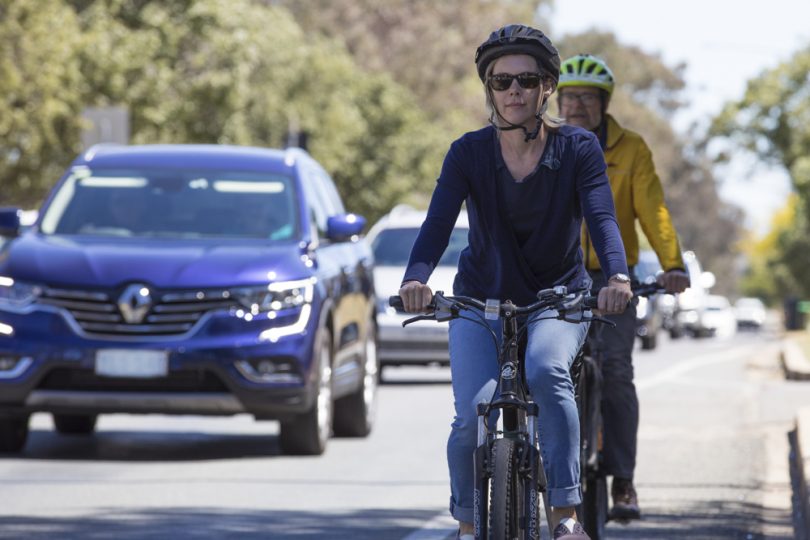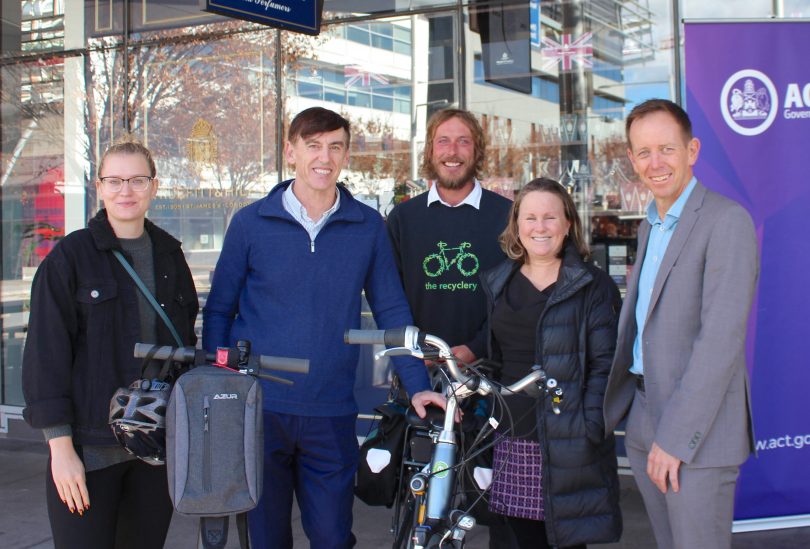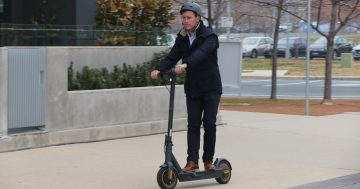
Commuters are being encouraged to ride bikes, e-bikes or e-scooters to work during the Make the Move campaign. Photo: Michelle Kroll.
Would you be willing to ditch the daily commute in your car to take an active form of travel such as a bike, electric bike or e-scooter?
That is the question Canberra commuters are being asked as part of an initiative to make the move to zero-emission forms of transport.
The Make the Move initiative is a six-week program for workplaces to receive a tailored workshop and to trial the use of electric bikes and e-scooters which enable employees to replace their car commutes with active travel.
Four workplaces have already signed on to the program, including inner-city men’s barbershop Truefitt & Hill, digital design agency Annex, advocacy organisation Early Childhood Australia, and Canberra’s water and sewerage supplier Icon Water.
E-bikes and e-scooters have been provided by Switched On Cycles, and the project is supported by the ACT Government’s Community Zero Emissions Grants Program with $39,572 in funding.
ACT Minister for Emissions Reduction Shane Rattenbury said the program, delivered by the Conservation Council ACT Region and the Canberra Environment Centre, will help the community make real change to reduce emissions.
“Now that the ACT has shifted to 100 per cent renewable electricity, transport emissions are by far the ACT’s biggest source of greenhouse gas emissions, at more than 60 per cent,” said Mr Rattenbury.
“That’s why we have a strong focus on shifting to zero-emissions transport, including active travel and zero-emissions vehicles.
“Expert advice will also be provided to businesses about how they can further support their employees’ sustainable transport choices. This includes advice on areas such as vehicle charging, storage and improved end-of-trip facilities.”

From left: Samantha Ward and Gregory Mowle from Early Childhood Australia; Ryan Lungu from Canberra Environment Centre; Conservation Council ACT Region executive director Helen Oakey; and ACT Minister for Emissions Reduction Shane Rattenbury. Photo: Supplied.
Executive director of the Conservation Council ACT Region Helen Oakey said the initiative encourages businesses and commuters to overcome the barriers of changing their daily travel habits by encouraging sustainable modes of travel.
“By switching regular work commuting out of cars and into a range of different transport options, we’re keen to help two-car families realise the cost savings and health benefits of running just a single family car,” she said.
“With around a quarter of all travel undertaken getting to and from work, employers have the opportunity to make a significant contribution towards changing Canberrans’ travel habits while reducing their organisation’s carbon emissions and reaping the benefits of a healthier and more active workforce.”
Ms Oakey said the Make the Move website also answers questions many people will have about how to plan their daily commute, as well as dealing with Canberra’s cold days and how to manage urgent appointments or picking up children.
“Canberrans travel around the city daily for employment, social, recreational and household activities, clocking up a staggering 11 million kilometres a day,” she said.
“Of that, more than nine million kilometres are in private vehicles mostly carrying just one person. All that driving has significant impacts on our health, our climate and the city’s amenity.”
Regional manager of Truefitt & Hill John Murphy said his staff are enthusiastic about developing more sustainable transport habits that also improve their physical and mental health.
“Truefitt & Hill is committed to continuously trying to be a better and greener corporate citizen, and participating in the Make the Move project is another step in that direction,” he said.
Canberra Environment Centre executive director Ryan Lungu said the program allows commuters to try before they buy to see what works best, while principal consultant at Annex, Tim Berman, said his team is already very conscious of finding more energy efficient methods of travel without making the usual excuses.
“One of the barriers to having a greater uptake of our staff using bikes to get to work is the distance that some staff would have to cycle, as well as the distance to local bus stops if staff wanted to catch a bus,” said Early Childhood Australia finance and operations general manager Gregory Mowle.
“Having the ability to trial e-bikes and e-scooters will help eliminate these barriers.”
Icon Water health and wellness coordinator Michael Nolan said the program aligned with the organisation’s wellbeing and environmental strategies.
“The Make the Move program aligns with the Icon Water Live Well Framework, supporting healthier bodies, healthier minds and healthier place, as well as the ACT Government’s target of reaching net-zero emissions by 2045.”
More information on the Make the Move project is available on the Conservation Council ACT Region website.














